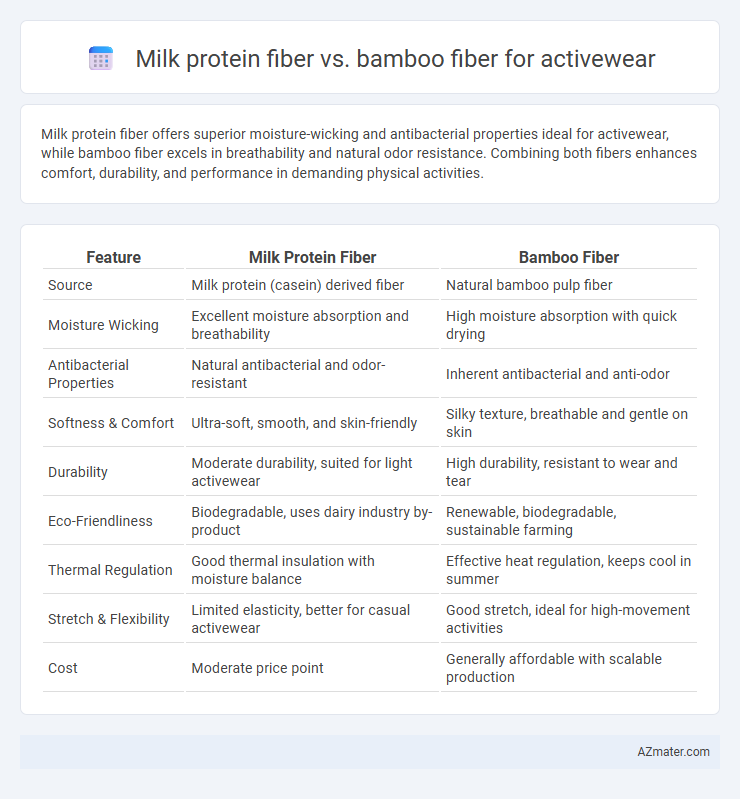Milk protein fiber offers superior moisture-wicking and antibacterial properties ideal for activewear, while bamboo fiber excels in breathability and natural odor resistance. Combining both fibers enhances comfort, durability, and performance in demanding physical activities.
Table of Comparison
| Feature | Milk Protein Fiber | Bamboo Fiber |
|---|---|---|
| Source | Milk protein (casein) derived fiber | Natural bamboo pulp fiber |
| Moisture Wicking | Excellent moisture absorption and breathability | High moisture absorption with quick drying |
| Antibacterial Properties | Natural antibacterial and odor-resistant | Inherent antibacterial and anti-odor |
| Softness & Comfort | Ultra-soft, smooth, and skin-friendly | Silky texture, breathable and gentle on skin |
| Durability | Moderate durability, suited for light activewear | High durability, resistant to wear and tear |
| Eco-Friendliness | Biodegradable, uses dairy industry by-product | Renewable, biodegradable, sustainable farming |
| Thermal Regulation | Good thermal insulation with moisture balance | Effective heat regulation, keeps cool in summer |
| Stretch & Flexibility | Limited elasticity, better for casual activewear | Good stretch, ideal for high-movement activities |
| Cost | Moderate price point | Generally affordable with scalable production |
Introduction: The Rise of Innovative Fibers in Activewear
Milk protein fiber and bamboo fiber represent groundbreaking developments in activewear textiles, offering distinct performance benefits. Milk protein fiber is prized for its moisture-wicking, antibacterial properties, and soft texture that enhances comfort during intense workouts. Bamboo fiber stands out for its natural breathability, UV protection, and eco-friendly production, making it a popular choice for sustainable activewear brands.
Overview of Milk Protein Fiber: Composition and Properties
Milk protein fiber, derived from casein protein extracted from milk, offers unique properties such as softness, breathability, and moisture-wicking, making it ideal for activewear. Its composition includes amino acids that provide a smooth, silk-like texture while enhancing antibacterial and skin-calming effects. Compared to bamboo fiber, milk protein fiber excels in comfort and skin-friendliness but may require specialized care to maintain its durability and performance in high-intensity activities.
Bamboo Fiber Basics: Structure and Unique Qualities
Bamboo fiber is derived from the cellulose of bamboo plants and is characterized by its natural hollow structure, which enhances breathability and moisture-wicking properties, making it ideal for activewear. Its antimicrobial qualities help reduce odor buildup, while its softness and durability offer comfort during high-intensity activities. Unlike milk protein fiber, which is protein-based and offers skin-friendly benefits, bamboo fiber excels in sustainability and environmental friendliness, being biodegradable and requiring less water and pesticides to produce.
Sustainability Comparison: Eco-Friendliness of Milk and Bamboo Fibers
Milk protein fiber is made from casein protein extracted from milk, which uses a renewable resource with relatively low environmental impact compared to synthetic fibers. Bamboo fiber is derived from bamboo plants, known for rapid growth and minimal pesticide use, making it highly sustainable, but conventional chemical processing methods can reduce its eco-friendliness. Both fibers offer biodegradable properties, but bamboo's natural regeneration rate and less intensive farming practices generally position it as the more sustainable option for activewear materials.
Moisture-Wicking and Breathability: Which Fiber Performs Better?
Milk protein fiber offers excellent moisture-wicking properties by quickly absorbing sweat and dispersing it across the fabric surface, promoting rapid evaporation and keeping the skin dry during intense workouts. Bamboo fiber excels in breathability due to its natural micro-gaps and hollow structure, allowing better airflow and temperature regulation, which enhances comfort in activewear. While milk protein fiber prioritizes moisture management for high-performance use, bamboo fiber delivers superior ventilation, making the optimal choice dependent on specific activity demands.
Comfort and Skin Sensitivity: Milk Protein vs Bamboo Fiber
Milk protein fiber offers superior softness and moisture-wicking properties, making it ideal for activewear designed for sensitive skin. Bamboo fiber also excels in breathability and natural antibacterial qualities, reducing irritation during intense workouts. Comparing both, milk protein fibers provide a silkier feel, while bamboo fibers contribute enhanced temperature regulation and odor control.
Durability and Care: Longevity in Activewear Applications
Milk protein fiber and bamboo fiber both offer sustainable options for activewear, but milk protein fiber excels in durability due to its strength and resistance to pilling, extending garment longevity under frequent washing and intense physical activity. Bamboo fiber, while naturally antibacterial and moisture-wicking, tends to weaken faster with repeated laundering, impacting its long-term performance in high-stress athletic wear. Proper care of milk protein fiber involves gentle washing and avoiding high heat, which helps maintain its structural integrity and shape retention, making it a superior choice for durable activewear applications.
Antibacterial and Odor-Resistance: Activewear Hygiene Showdown
Milk protein fiber exhibits strong antibacterial properties due to its natural casein proteins that inhibit bacterial growth, making it highly effective in odor resistance for activewear. Bamboo fiber contains natural antimicrobial agents like bamboo kun, which also provide excellent odor control and moisture-wicking capabilities. Comparing these fibers, milk protein fiber offers superior antibacterial effects, while bamboo fiber excels in breathability and skin comfort, both enhancing activewear hygiene.
Cost and Accessibility: Market Availability and Affordability
Milk protein fiber offers moderate cost and is less widely available, limiting its accessibility in the activewear market compared to bamboo fiber. Bamboo fiber is more affordable and benefits from higher market availability due to sustainable cultivation and established manufacturing processes. Brands favor bamboo fiber for cost-effective production and widespread consumer access, making it a popular choice for activewear textiles.
Conclusion: Choosing the Best Fiber for Your Active Lifestyle
Milk protein fiber offers exceptional moisture-wicking, antibacterial properties, and softness, making it ideal for sensitive skin during intense workouts. Bamboo fiber excels in breathability, natural UV protection, and sustainability, supporting eco-friendly activewear choices. Selecting the best fiber depends on your priority between performance comfort and environmental impact for an optimized active lifestyle.

Infographic: Milk protein fiber vs Bamboo fiber for Activewear
 azmater.com
azmater.com